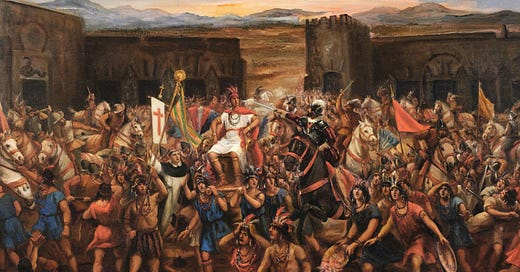The capture, and subsequent murder, of the Incan emperor, demigod Atahualpa, by Francisco Pizarro, an illiterate bastard from rural Spain, might be the most dramatic plot twist in human history. A ragtag band of 168 men went into the middle of an army of 40,000, killed 6000 in a single massacre, and by seizing Atahualpa, who Pizarro grabbed by the arm and pulled out from his royal litter, took control of an empire multiple times the size of Spain in both area and population.
It’s not like the Incas were all nice and wholesome. The book that I’m reading, “The Last Days of the Incas” by Kim MacQuarrie, makes a point that the Incan empire itself, which was only 40 years old at the time of Pizarro’s arrival in 1532, was based on the subjugation of vast numbers of people to a tiny elite of ethnic Incas based in Cusco (and in fact the very idea of this enterprise we call civilization is based on the subjugation of food producers by ruling elites). Incas were pretty brutal — to others and even to each other. For example, they had no mechanism of deciding royal succession other than all-out-war between brothers, which was expected and even encouraged as a way to select the most worthy one. When Atahualpa beat his brother Huascar to the throne, he imprisoned him, and later ordered his murder, even as he himself was in Spanish captivity and about to see his empire ripped apart. He also murdered his brother’s soldiers, their wives, their children, and even unborn children who were cut from their mother’s wombs. In short, Incas weren’t much more pleasant than Spaniards at the time.
But there’s one element of the story where the two peoples diverged: gold.
It was obvious to Atahualpa and his army that Pizarro’s men were obsessed with gold and silver. But the Incas could not understand why. The Spanish acted just like the barbarians on the fringes of the Incan empire, who always had a fascination with any Incan craft. So Atahualpa thought that the Spanish were the same — they wanted pretty goblets and fine ornaments for their homes. So he walked into a large chamber, took a piece of chalk, reached as high as he could and drew a line on the wall. I will fill this chamber with gold objects to this line, he said. Will you leave? Sure, said Pizarro, obviously with no intention of honoring the pledge. And so, upon Atahualpa’s orders, gold started flowing to the chamber from the whole Incan empire. The Incas were distinct from other Andean people in deifying their rulers, who were believed to be descended from the Sun. Gold also represented the sun, and so was used for ceremonial and religious purposes. It did not occur to Atahualpa that the Spanish weren’t interested in the objects of fine Incan craftsmanship, but in the material from which they were made, which, coincidentally, happened to be the material from which Old World people made money. The Incas knew what money was — some peoples they traded with used lumps of copper as their medium of exchange — but themselves relied on barter and top-down redistribution of goods and services.
And so to me, the scene that follows is as symbolically significant as Pizarro grabbing Atahualpa by the arm. As the chamber fills up with gold scrapped from temples all over the empire, the Spanish begin to melt it. Right in front of the Incas, and Atahualpa himself.
The only two ways in which gold and silver are special is that they are rare — and so can be used as money — and that they look beautiful. The Spanish only cared about the first one, and the Incas only about the second one.
The irony is that, when the huge quantities of gold and silver, now shaped into simple bricks, were imported into Spain by Pizarro and others, gold and silver became a lot less rare, which caused runaway inflation — known as the Spanish Price Revolution. Prices increased sixfold over 150 years, eventually leading to the decline of the Spanish monarchy and the ascent of the Dutch and the British. So, paradoxically, turning beauty into money made its value go away.
Of course, today, the few Inca relics that survived are vastly more valuable than the gold they are made of.
What the Incas knew, and the illiterate Spaniards did not understand, is that beauty is one of few things in the world that does not expire.
I’m writing this post from Lima, Peru. We just got back from a 4-day Santa Cruz trek in the Cordilleras Blancas. Today we are headed to Cusco, the ancient Incan capital!





